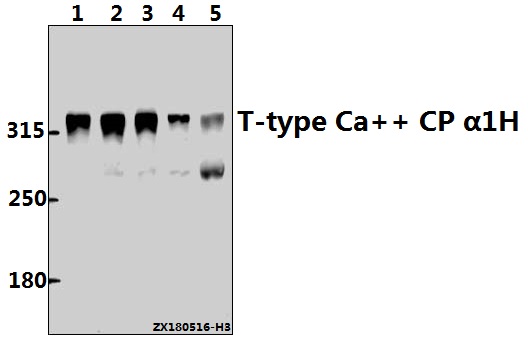Product Name :
T-type Ca++ CP α1H (P492) polyclonal antibody Background :
Voltage-dependent Ca++ channels mediate Ca++ entry into excitable cells in response to membrane depolarization, and they are involved in a variety of Ca++-dependent processes, including muscle contraction, hormone or neurotransmitter release and gene expression. Calcium channels are highly diverse, multimeric complexes composed of an α1 subunit, an intracellular β subunit, a disulfide linked α2/δ subunit and a transmembrane γ subunit. Ca++ currents are characterized on the basis of their biophysical and pharmacologic properties and include L-, N-, T-, P-, Q-, and R- types. T-type Ca++ currents are activated and inactivated more rapidly and at more negative membrane potentials than other Ca++ current types. T-type Ca++ channels enhance odor sensitivity by lowering the threshold of spike generation in olfactory receptor cells (ORCs). Product :
Rabbit IgG, 1mg/ml in PBS with 0.02% sodium azide, 50% glycerol, pH7.2 Storage&Stability :
Store at 4°C short term. Aliquot and store at -20°C long term. Avoid freeze-thaw cycles. Specificity :
T-type Ca++ CP α1H (P492) polyclonal antibody detects endogenous levels of T-type Ca++ CP α1H protein. Immunogen :
Synthetic peptide, corresponding to amino acids 461-510 of Human T-type Ca++ CP α1H. Conjugate :
Unconjugated Modification :
Unmodification
T-type Ca++ CP α1H (P492) polyclonal antibody Background :
Voltage-dependent Ca++ channels mediate Ca++ entry into excitable cells in response to membrane depolarization, and they are involved in a variety of Ca++-dependent processes, including muscle contraction, hormone or neurotransmitter release and gene expression. Calcium channels are highly diverse, multimeric complexes composed of an α1 subunit, an intracellular β subunit, a disulfide linked α2/δ subunit and a transmembrane γ subunit. Ca++ currents are characterized on the basis of their biophysical and pharmacologic properties and include L-, N-, T-, P-, Q-, and R- types. T-type Ca++ currents are activated and inactivated more rapidly and at more negative membrane potentials than other Ca++ current types. T-type Ca++ channels enhance odor sensitivity by lowering the threshold of spike generation in olfactory receptor cells (ORCs). Product :
Rabbit IgG, 1mg/ml in PBS with 0.02% sodium azide, 50% glycerol, pH7.2 Storage&Stability :
Store at 4°C short term. Aliquot and store at -20°C long term. Avoid freeze-thaw cycles. Specificity :
T-type Ca++ CP α1H (P492) polyclonal antibody detects endogenous levels of T-type Ca++ CP α1H protein. Immunogen :
Synthetic peptide, corresponding to amino acids 461-510 of Human T-type Ca++ CP α1H. Conjugate :
Unconjugated Modification :
Unmodification
-
 Western blot (WB) analysis of T-type Ca++ CP α1H (P492) pAb at 1:500 dilution Lane1:L02 whole cell lysate(40ug) Lane2:HepG2 whole cell lysate(40ug) Lane3:PC3 whole cell lysate(20ug) Lane4:AML-12 whole cell lysate(40ug) Lane5:H9C2 whole cell lysate(40ug)
Western blot (WB) analysis of T-type Ca++ CP α1H (P492) pAb at 1:500 dilution Lane1:L02 whole cell lysate(40ug) Lane2:HepG2 whole cell lysate(40ug) Lane3:PC3 whole cell lysate(20ug) Lane4:AML-12 whole cell lysate(40ug) Lane5:H9C2 whole cell lysate(40ug)
Bioworld Biotech only provide peptides for our antibodies and do not provide additional peptide customization services.
Price/Size :
USD 368/1mg/vial
Tips:
For phospho antibody, we provide phospho peptide(0.5mg) and non-phospho peptide(0.5mg).Describe :
Blocking peptides are peptides that bind specifically to the target antibody and block antibody binding. These peptide usually contains the epitope recognized by the antibody. Antibodies bound to the blocking peptide no longer bind to the epitope on the target protein. This mechanism is useful when non-specific binding is an issue, for example, in Western blotting (WB) and Immunohistochemistry (IHC). By comparing the staining from the blocked antibody versus the antibody alone, one can see which staining is specific; Specific binding will be absent from the western blot or IHC performed with the neutralized antibody.Formula:
Synthetic peptide was lyophilized with 100% acetonitrile and is supplied as a powder. Reconstitute with 0.1 ml DI water for a final concentration of 10 mg/ml.The purity is >90%,tested by HPLC and MS.
Storage:
The freeze-dried powder is more stable. For short time at 2-8°C. For long term storage store at -20°C.
Note :
This product is for research use only (RUO only). Not for use in diagnostic or therapeutic procedures.
 T-type Ca++ CP α1H (P492) polyclonal antibody
T-type Ca++ CP α1H (P492) polyclonal antibody  Datasheet
Datasheet COA
COA MSDS
MSDS SHIP
SHIP